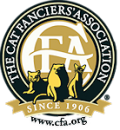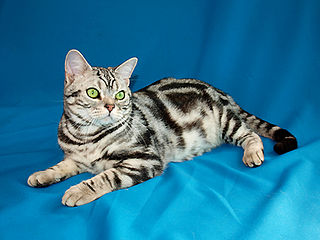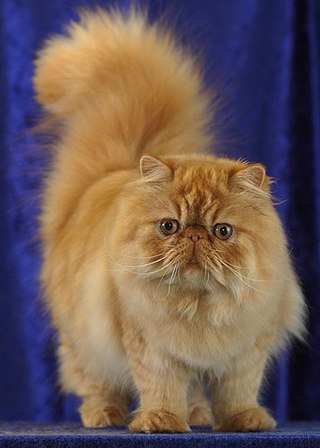
The York Chocolate is an uncommon American breed of show cat, with a long, fluffy coat and a tapered tail and most of them were mostly or entirely chocolate-brown or the dilute form of brown, known as lavender. The breed was named after New York state, where it was established in 1983. This breed was created by color-selecting domestic long-haired cats of mixed ancestry. The breed is not widely recognized by cat registries. It is not recognized by the major organizations such as The International Cat Association (TICA), the Cat Fanciers' Association or Fédération Internationale Féline.

The Maine Coon is a large domesticated cat breed. One of the oldest natural breeds in North America, the breed originated in the U.S. state of Maine, where it is the official state cat.

The Cymric is a Canadian cat breed. Some cat registries consider the Cymric a semi-long-haired variety of the Manx breed, rather than a separate breed. Except for the length of fur, in all other respects, the two varieties are the same, and kittens of either sort may appear in the same litter. The name comes from Cymru, the indigenous Welsh name of Wales, even though the breed is not associated with Wales. The name may have been chosen to provide a "Celtic" sounding moniker for the breed. While the breed's Manx bloodline originated from the Isle of Man, the long-haired variant is claimed to have been developed by Canada. The breed is called the Longhair Manx or a similar name by some registries.

The American Bobtail is an uncommon breed of domestic cat which was developed in the late 1960s. It is most notable for its stubby "bobbed" tail about one-third to one-half the length of a normal cat's tail. This is the result of a cat body type genetic mutation affecting the tail development, similar to that of a Manx cat. The breed is not related to other short-tailed breeds, such as the Cymric cat, or the Japanese Bobtail or Kurilian Bobtail, despite the similar name and physical type—the breeding programs are entirely unrelated, and the genetic mutation causing the bobbed tail are known to be different, as the mutation causing the American Bobtail's short tail is dominant; comparatively, the Japanese Bobtail, for example, has a tail mutation that is recessive.

The Cat Fanciers' Association (CFA) was established in the United States in 1906. The CFA is currently the world's largest registry of pedigreed cats. Originally headquartered in Manasquan, New Jersey, the CFA moved to Alliance, Ohio in 2010. The association's stated mission is preserving and promoting pedigreed breeds of cats while also enhancing the well-being of all cats. CFA's first licensed cat shows were held in Buffalo, New York and Detroit, Michigan in 1906. The association today has a known presence in Europe, China, and Japan along with its well-established activity in the United States and Canada.

The American Shorthair (ASH) is a breed of domestic cat believed to be descended from European cats brought to North America by early settlers to protect valuable cargo from mice and rats. According to the Cat Fanciers' Association, it was the eighth most popular pedigreed cat in the world for 2020.

The Javanese, also known as the ColorpointLonghair in some registries, is a variety of purebred domestic cat.

The Oriental Shorthair is a breed of domestic cat that is developed from and closely related to the Siamese cat. It maintains the modern Siamese head and body type but appears in a wide range of coat colors and patterns. Like the Siamese, Orientals have almond-shaped eyes, a triangular head shape, large ears, and an elongated, slender, and muscular body. Their personalities are also very similar. Orientals are social, intelligent, and many are rather vocal. They often remain playful into adulthood, with many enjoying playing fetch. Despite their slender appearance, they are athletic and can leap into high places. They prefer to live in pairs or groups and also seek human interaction. Unlike the breed's blue-eyed forebear, Orientals are usually green-eyed. The Oriental Longhair differs only with respect to coat length.

The Singapura, or Kucinta in Singapore, is the smallest breed of cat, noted for its large eyes and ears, ticked coat, and blunt tail. Reportedly established from three "drain cats" imported from Singapore in the 1970s, it was later revealed that the cats were originally sent to Singapore from the United States before being exported back to the US. Investigations by the Cat Fanciers' Association (CFA) concluded that no wrongdoing had occurred and the Singapura kept its status as a natural breed.

The Snowshoe is a rare breed of domestic cat originating in the United States of America in the 1960s. The Snowshoe is a short-haired bicolour colourpoint breed. Snowshoes were first produced when a Siamese breeder's cat gave birth to three kittens with white feet. The breeder, Dorothy Hinds-Daugherty, then began a breeding program to produce what were originally called "Silver Laces", crossing the strangely marked Siamese cats with bicolour American Shorthair cats and other breeds. Despite having existed for 45 years, Snowshoes are rare due to the difficulty of reproducing the correct coat markings.
A cat show is a judged event where the owners of cats compete to win titles in various cat registering organizations by entering their cats to be judged after a breed standard. Both pedigreed and companion cats are admissible, although the rules differ from organization to organization. Cats are compared to a breed standard, and the owners of those judged to be closest to it are awarded a prize. Moggys are judged based on their temperament. Often, at the end of the year, all of the points accrued at various shows are added up and more national and regional titles are awarded.

The Ragamuffin is a breed of domestic cat. It was once considered to be a variant of the Ragdoll cat but was established as a separate breed in 1994. Ragamuffins are notable for their friendly personalities and thick fur.
A cat registry or cat breed registry, also known as a cat fancier organization, cattery federation, or cat breeders' association, is an organization that registers domestic cats of many breeds, for exhibition and for breeding lineage tracking purposes. A cat registry stores the pedigrees (genealogies) of cats, cattery names, and other details of cats; studbooks, breed descriptions, and the formal breed standards ; lists of judges qualified to judge at shows run by or affiliated with that registry, and sometimes other information. A cat registry is not the same as a breed club or breed society. Cat registries each have their own rules and usually also organize or license (sanction) cat shows. The show procedures vary widely, and awards won in one registry are not normally recognized by another. Some registries only serve breeders, while others are oriented toward pet owners and provide individual as well as cattery memberships, while yet others are federations only deal with breed clubs or even other registries as intermediaries between the organization and breeders.

The American Cat Fanciers Association (ACFA) is an American non-profit organization formed with the intent of allowing greater flexibility in the development of pedigreed cats. The ACFA is a cat registry for purebred, pedigreed cats, experimental breeds of cats, and household pet cats.
The Cat Aficionado Association (CAA) is China's largest registry of pedigreed cats and is recognized internationally in conjunction with American Cat Fanciers Association (ACFA) as the premiere pedigreed cat registering association in Asia. Headquartered in Beijing, China, CAA was established on March 3, 2001.

The Canadian Cat Association is a non-profit organization in Canada whose mission is to promote the welfare of all cats in Canada, maintain a registry of pedigreed cats in Canada, and further the improvement of all breeds of cats in Canada. CCA-AFC is Canada's only globally-recognized national cat registry, with its pedigrees and registrations accepted by major global associations such as the Cat Fanciers' Association, The International Cat Association, and Fédération Internationale Féline. To date, CCA-AFC has registered over 190,000 cats.

The Persian cat, also known as the Persian Longhair, is a long-haired breed of cat characterised by a round face and short muzzle. The first documented ancestors of Persian cats might have been imported into Italy from Khorasan as early as around 1620, however, this has not been proven. Instead, there is stronger evidence for a longhaired cat breed being exported from Iran from the 19th century onwards. Persian cats have been widely recognised by the North-West European cat fancy since the 19th century, and after World War II by breeders from North America, Australia and New Zealand. Some cat fancier organisations' breed standards subsume the Himalayan and Exotic Shorthair as variants of this breed, while others generally treat them as separate breeds.

The Balinese is a long-haired breed of domestic cat with Siamese-style point coloration and sapphire-blue eyes. The Balinese is also known as the purebred long-haired Siamese since it originated as a natural mutation of that breed and hence is essentially the same cat but with a medium-length silky coat and a distinctively plumed tail.


















